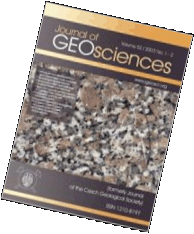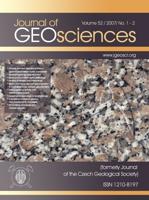 Export to Mendeley
Export to MendeleyBohemian Massif
Moldanubian Zone
geochemistry
granite
petrology
dykes and minor intrusions
More articles on Granitic magmatism in collisional orogens
Original Paper
Geochemical variability of granite dykes and small intrusions at the margin of the Granulite Complex in southern Bohemia
Journal of Geosciences, volume 61 (2016), issue 2, 145 - 170
DOI: http://doi.org/10.3190/jgeosci.213
The study is focused on the composition of various types of Moldanubian dyke granites in the Bohemian Forest (Czech Republic). The studied area of about 200 km2 is mainly in the northern environs of the Lipno dam lake on the Vltava River. This territory consists of metamorphic units such as Blanský les and Křišťanov granulite massifs associated with metasedimentary migmatite complexes of Monotonous and Varied units, intruded by Knížecí Stolec durbachite pluton and post-tectonic Variscan granitoids. The range of granite samples includes leucocratic rocks with muscovite, or with muscovite and biotite, and types with biotite as the single mica. Tourmaline- and garnet-bearing granites are less common. The set of 25 samples characterizes the composition of 20 dykes and small intrusions.
A simple provisional division of granite samples into low-Ca (0.35-0.65 wt. % CaO) and medium-Ca (0.67-1.16 wt. % CaO) groups is used. Tourmaline granites (± Ms, Grt) contain schorl with 20-40 mol. % dravite. Garnets contain almandine and spessartine as the major components (c. 30 mol. % Sps) but the sample from the Hrad hill exhibits an outer zone containing up to 32 mol. % Grs. Apatite occurs in several generations, especially in low-Ca granites, which have a significant phosphorus substitution in feldspars: 1) primary fluorapatite, 2) minute anhedral apatite (containing P unmixed from albite) contains up to c. 10 mol. % of chlorapatite component in predominating fluorapatite, 3) very rare (hydrothermal) hydroxylapatite filling brittle fractures in tourmaline. Accessory cordierite, originally present in some leucogranites, is altered to pinite (muscovite + chlorite ± biotite aggregate). Several samples from the Smrčina area contained cordierite with low Be, which has been unmixed as a newly formed tiny beryl in pinite.
The dataset exhibits geochemical heterogeneity. Low-Ca and medium-Ca granites are distinct in the Ba-Rb-Sr ternary, as well as in the of Zr/Hf vs. Y/Ho and SiO2 vs. A/CNK plots. The low-Ca dyke granites show numerous chemical differences from the granites of the plutonic bodies (such as the Eisgarn or Deštná types of the Moldanubian Batholith). The medium-Ca granite dykes split into the Smrčina type and remaining types of muscovite-biotite granites. Several types of chondrite-normalized REE patterns can be distinguished in terms of the total REE contents, the degree of LREE over HREE enrichment and magnitude of the Eu anomaly; most of the patterns show clearly a tetrad effect.
Webdesign inspired by aTeo. Hosted at the server of the Institute of Petrology and Structural Geology, Charles University, Prague.
ISSN: 1803-1943 (online), 1802-6222 (print)
email: jgeosci(at)jgeosci.org


IF (WoS, 2024): 1.3
5 YEAR IF (WoS, 2024): 1.4
Policy: Open Access
ISSN: 1802-6222
E-ISSN: 1803-1943